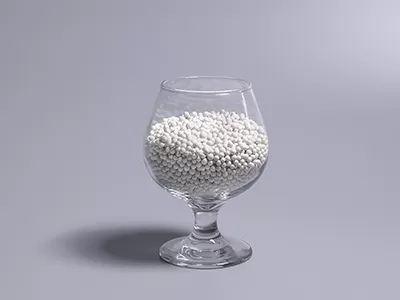Activated alumina, also known as activated alumina beads, is a material with high adsorption capacity, thermal stability and chemical stability.
It is made from aluminate or aluminium hydroxide as raw materials and is formed into tiny spherical particles under high-temperature conditions. The porosity of these particles is over 40%.
Activated alumina has broad application prospects in the fields of environmental protection, energy, and the chemical industry.
The spherical active alumina direct current transformer oil absorber is a milky white spherical porous structure particle. The active alumina has a uniform particle size distribution, a smooth surface, high impact toughness, strong water absorption capacity, and does not expand or crack when absorbing moisture and maintaining its original shape after absorbing moisture. It is non-toxic, odorless, insoluble in water and ethyl acetate.
The preparation method of activated alumina
The preparation methods of active alumina mainly include two types: physical methods and chemical methods.
Physical method: By using high temperature, high pressure and high-speed rotation, the aluminum oxide or aluminum hydroxide particles are transformed into spherical particles under specific conditions.
The activated alumina prepared by the physical method has the advantages of uniform particle size distribution and smooth surface.

Chemical method: Using methods such as sol-gel method, hydrothermal method, and co-precipitation method, spherical particles can be obtained through chemical reactions.
1. The activated alumina prepared by the chemical method has the advantages of a more complete pore structure and a more uniform pore size distribution.
2. Properties of Active Aluminum Oxide
The active alumina has a high specific surface area and porosity, and there are a large number of oxygen vacancies on its surface, which makes it have strong adsorption and catalytic properties.
Meanwhile, the activated alumina also possesses excellent high-temperature resistance and chemical stability, and is not easily eroded by water, acids, alkalis and other chemical substances.
Therefore, activated alumina has broad application prospects in areas such as adsorption, catalysis, and separation.

3. Applications of Active Aluminum Oxide
(1) Adsorption materials: Activated alumina has excellent adsorption properties and can be used in fields such as air purification, water treatment, and waste gas treatment.
For instance, using activated alumina as an adsorbent for waste gas treatment can effectively remove harmful gases such as sulfur dioxide and nitrogen oxides.
(2) Catalyst carrier: Activated alumina is used as the catalyst carrier, which can enhance the catalytic activity and selectivity of the catalyst.
For instance, in the petrochemical industry, activated alumina is often used as a catalyst carrier, being employed in reactions such as hydrogenation, dehydrogenation, and cracking.
(3) Separation material: Activated alumina has a high specific surface area and porosity, and can be used for the preparation of separation materials.
For instance, using activated alumina as a separation material can significantly enhance the efficiency and selectivity of separating organic substances.
4. The Development Prospects of Active Aluminum Oxide
With the development of environmental protection, energy and chemical industries, the demand for efficient, environmentally friendly and sustainable new materials is increasing rapidly.
Activated alumina, as a material with excellent performance and promising application prospects, will be applied more widely in the future development.


.jpg)
.jpg)
.jpg)
.jpg)